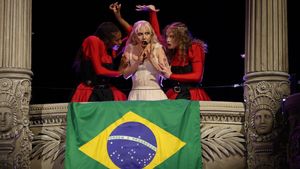(CNN) — Día de los Muertos, known in English as Day of the Dead, is a time-honored tradition in Mexico with origins that go back thousands of years.
In the US, you’ve probably seen the signs commonly associated with the holiday: papel picado (colorful paper with cutouts), calaveras (skulls), and marigold flowers. The holiday is also heavily featured in the movie Cocoand the opening scene of Spectre.
Día de los Muertos is a tribute to the afterlife, a day meant to honor those who have died and keep their memory alive. Unlike Halloween, which historically was a day to ward off evil spirits, Day of the Dead is more about paying respects to loved ones who have died.
Here’s what else you need to know about this special day.
When is Day of the Dead?
Day of the Dead always starts on November 1 and ends on November 2. During those days, it is believed that the spirits of the dead return home to spend time with their families.
Who celebrates Day of the Dead?
Although Day of the Dead is predominantly associated with Mexico, other countries, even those outside Latin America, also celebrate their own versions of the holiday. In the Philippines, the holiday is called Undas, and is also celebrated on the first two days of November. Just like in Mexico, Filipinos visit their loved ones’ graves and also create altars to those who have passed.
In Haiti, the day is called Fèt Gede, festival of the dead. People dress up in white, black, and purple, while parades are held across the country.
What are the origins of Day of the Dead?
Day of the Dead originates from rituals practiced by Indigenous people in the Americas, most notably the Aztecs. The Aztecs had a ritual known as Miccaihuitl, which was a time to honor the dead.
But when the Spanish arrived to the Americas, they brought Catholicism, which had its own celebrations: All Saints’ Day (November 1) and All Souls’ Day (November 2), both of which also commemorate those who have passed. The Spanish then incorporated their own holidays with Indigenous traditions, which evolved into Día de los Muertos.
What are Day of the Dead traditions?
Many people honor Day of the Dead by visiting the graves of dead relatives and loved ones. But they don’t necessarily go to mourn; instead, they clean the graves and headstones or decorate them with flowers. Some might pray, while others play music.
The environment almost resembles a party, with music, food, and drinks. People come together to share stories of their loved ones — helping keep their memory alive.
Some cities in Mexico also celebrate the day with parades and festivals. Many will paint their face to resemble a bare skull and wear costumes. Women especially will dress up as La Catrina, a tall female skeleton commonly depicted wearing a fancy gown and a lavish hat flaring over her head.
Though characters like La Catrina have become a symbol of Día de los Muertos, the imagery originates from Mexican artist José Guadalupe Posada, who sketched it in 1910 as a mockery of Mexico’s upper classes.
What are ofrendas?
One of the most sacred aspects of Day of the Dead are the altars, called ofrendas. These altars are built in homes, schools, or other public places to honor the deceased.
Family members will top the altar with a large photo of the loved one, along with colorful papel picado, which translates to “perforated paper.” The color tissue papers represent air as the four elements are meant to be portrayed in the altars. Marigold petals are also featured throughout the altars, which are meant to guide the spirits back home with their bright color and pungent scent. Candles,both to light the way and represent the deceased, are also commonly seen on the ofrendas, as well as pan de muerto, a traditional Mexican pan dulce rooted in Aztec customs. Skulls made of sugar, also commonly placed on ofrendas, are meant to allude to the ever-present nature of death.
Salt, often placed in the shape of a cross, is placed on or in the vicinity of the ofrenda as a means to purify the visiting souls. Families will also place a container of water, and sometimes tequila, on the altars, so souls can quench their thirst after their journey.
But these altars can also be personal. Some families will include the deceased’s favorite food or personal tokens from their lives, like a favorite book or a shirt. All of it serves both as a way of remembering the dead and honoring them in their return.
The-CNN-Wire
™ & © 2023 Cable News Network, Inc., a Warner Bros. Discovery Company. All rights reserved.


















































